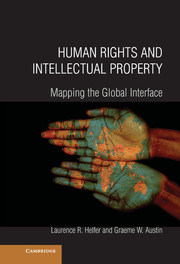Book contents
- Frontmatter
- Contents
- Preface
- 1 Mapping the Interface of Human Rights and Intellectual Property
- 2 The Human Right to Health, Access to Patented Medicines, and the Restructuring of Global Innovation Policy
- 3 Creators' Rights as Human Rights and the Human Right of Property
- 4 Rights to Freedom of Expression, to Cultural Participation, and to Benefit from Scientific Advancements
- 5 The Right to Education and Copyright in Learning Materials
- 6 The Human Right to Food, Plant Genetic Resources, and Intellectual Property
- 7 Indigenous Peoples' Rights and Intellectual Property
- 8 Conclusion
- References
- Acknowledgments
- Index
- Cases Discussed (Selected)
3 - Creators' Rights as Human Rights and the Human Right of Property
Published online by Cambridge University Press: 05 June 2012
- Frontmatter
- Contents
- Preface
- 1 Mapping the Interface of Human Rights and Intellectual Property
- 2 The Human Right to Health, Access to Patented Medicines, and the Restructuring of Global Innovation Policy
- 3 Creators' Rights as Human Rights and the Human Right of Property
- 4 Rights to Freedom of Expression, to Cultural Participation, and to Benefit from Scientific Advancements
- 5 The Right to Education and Copyright in Learning Materials
- 6 The Human Right to Food, Plant Genetic Resources, and Intellectual Property
- 7 Indigenous Peoples' Rights and Intellectual Property
- 8 Conclusion
- References
- Acknowledgments
- Index
- Cases Discussed (Selected)
Summary
Introduction
Key international human rights instruments recognize that “authors” – those responsible for creating works that are typically protected by intellectual property rights – are the beneficiaries of human rights. Analysis of the inter sections between human rights and intellectual property cannot therefore be entirely concerned with the potential of human rights to constrain intellectual property. Even if the human rights of creators are not equivalent to intellectual property rights, a disjunction we analyze later in this chapter, the recognition in international human rights law that creators have a right to the protection of the “moral and material interests” resulting from any scientific, literary, or artistic “production” of which he or she is the author – to paraphrase Article 27(2) or the 1948 Universal Declaration of Human Rights (UDHR) and Article 15(1)(c) of the International Covenant on Economic, Social and Cultural Rights (ICESCR) – certainly complicates reliance on human rights to limit intellectual property.
Human rights protections for those who do creative work date from the beginning of the international human rights movement. The drafting of the UDHR in the years immediately following World War II was broadly contemporaneous with the 1948 American Declaration on the Rights and Duties of Man, which likewise recognizes the right of everyone “to the protection of his moral and material interests as regards his inventions or any literary, scientific or artistic works of which he is the author.”
- Type
- Chapter
- Information
- Human Rights and Intellectual PropertyMapping the Global Interface, pp. 171 - 220Publisher: Cambridge University PressPrint publication year: 2011



